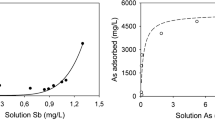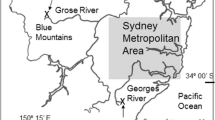Abstract
Mining operations commonly treat mine water prior to discharging it to the environment. Results of biological toxicity tests and Toxicity Identification Evaluations have shown that environmental risks can still exist for these highly treated waters. We present examples for mine waters that were treated using high density sludge–microfiltration–reverse osmosis and brine concentration processes. While such treatment substantially reduces the primary toxicity of the water, three key factors that could affect environmental consequences may arise or persist: (1) residual contaminants may still be at toxic concentrations, (2) the bioavailability of residual contaminants may increase, and (3) the treated water may be nutrient or major ion deficient. Appropriate strategies for the management of these treated waters should consider that toxicity or other water quality risks may still exist and that these will differ from those of the untreated water.
Zusammenfassung
Bergwerke reinigen normalerweise ihr Grubenwasser bevor es in den Vorfluter abgegeben wird. Die Ergebnisse von toxikologischen Tests sowie von Untersuchungen zur Toxizität zeigen, dass diese gut gereinigten Grubenwasser nach wie vor Umweltrisiken darstellen können. Wir präsentieren Beispiele von Grubenwässern die mittels Dickschlamm-Mikrofiltration-Umkehrosmose sowie weiterer Aufkonzentrierung des Konzentrats gereinigt wurden. Diese Prozesse verringern die ursprüngliche Toxizität des Wassers deutlich. Es kann jedoch dazu kommen, dass drei wichtige, umweltrelevante Faktoren entstehen oder bestehen bleiben: 1) Restverunreinigungen können in noch toxischen Konzentrationen vorliegen, 2) die Bioverfügbarkeit der Restverunreinigungen wird erhöht und 3) das Wasser kann einen Mangel an Nährstoffen oder Hauptionen aufweisen. Entsprechende Strategien für das Management dieser gereinigten Wässer sollten daher berücksichtigen, dass diese nach wie vor Toxizität oder Risiken aufweisen können, die sich von denen des ungereinigten Wassers unterscheiden.
Resumen
Las operaciones mineras usualmente tratan las aguas de minas antes de su descarga en el medio ambiente. Los resultados de ensayos de toxicidad biológica y evaluaciones de identificación de toxicidad (TIE) han mostrado que los riesgos ambientales pueden seguir existiendo en las aguas altamente tratadas. En este trabajo presentamos ejemplos sobre aguas de minas que fueron tratadas usando lodo de alta densidad-microfiltración-ósmosis reversa (HDS/MF/RO) y procesos de concentración de salmuera (BC). Mientras que tales tratamientos reducen substancialmente la toxicidad primaria del agua, tres factores principales que podrían traer consecuencias ambientales pueden persistir: 1) contaminantes residuales pueden aún estar en concentraciones tóxicas, 2) la biodisponibilidad de los contaminantes residuales puede incrementarse y, 3) el agua tratada puede ser deficiente en nutrientes o en iones. Estrategias apropiadas para el manejo de estas aguas tratadas deberían considerar que la toxicidad o los riesgos de calidad de agua pueden existir y que ellos diferirán de los que tiene el agua sin tratamiento.
抽象
采矿产生的矿井废水必须经过处理达标才能向环境排放。但是,生物毒理试验和毒理识别评价(TIE)表明矿井废水经深度处理后可能仍存在环境风险。本文研究了矿井废水经过高密度污泥-微滤-反渗膜(HDS/MF/RO)和卤水浓缩(BC)深度处理后的生态毒理学特征。虽然该处理工艺已经大幅消除了废水的毒性,但是处理后废水可能产生环境影响的三个关键因素仍然存在:(1) 残留污染物浓度可能仍处于毒性范围;(2) 残留污染物的生物药效可能增大;(3) 被处理水可能富含营养也可能主离子缺失。合理的水处理方案应该考虑水的毒性或其它水质风险依然存在,应该考虑处理前后毒理的变化。



Similar content being viewed by others
References
Adams MS, Stauber JL (2004) Development of a whole-sediment toxicity test using a benthic marine microalga. Environ Toxicol Chem 23:1957–1968
Aiken G, Malcolm R (1981) Molecular weight of aquatic fulvic acids by vapour pressure osmometry. Geochim Cosmochim Acta 51:2177–2184
Camilleri C, Hogan AC, Overall R (2002) Biological toxicity testing of water from the Ranger uranium mine process water treatment pilot plant. Darwin: Commercial-in-confidence report by Earth, Water, Life Sciences for Energy Resources of Australia, Darwin, NT, Australia
Charles AL, Markich SJ, Stauber JL, De Filippis LF (2002) The effect of water hardness on the toxicity of uranium to a tropical freshwater alga (Chlorella sp.). Aquat Toxicol 60:61–73
Gitter AH, Oliver D, Thurm U (1994) Calcium-and voltage-dependence of nematocyst discharge in Hydra vulgaris. J Comp Physiol A 175:115–122
Gunther P, Mey W (2006) Selection of mine water treatment technologies for the eMalahleni (Witbank) Water Reclamation Project. Paper presented at the Water Institute of South Africa Conf, Durban, South Africa. http://www.ewisa.co.za/literature/files/122%20Gunther.pdf
Harford AJ, van Dam RA, Hogan AC, Costello C (2008) Screening level toxicity assessment of treated Pond Water from a pilot plant at Ranger mine. Internal report 534, Supervising Scientist, Darwin, NT, Australia
Harford AJ, Hogan AC, Cheng KL, Costello C, Houston MA, van Dam RA (2009) Preliminary assessment of the toxicity of manganese to three tropical freshwater species. In Jones DR, Webb A (eds) Environmental Research Institute of the Supervising Scientist research summary 2007–2008, Supervising Scientist Report 200, Supervising Scientist, Darwin, NT, Australia, p 12–19. Accessed 2 Aug 2013. http://www.environment.gov.au/ssd/publications/ssr/200.html
Harford AJ, Jones DR, van Dam RA (2013) Highly treated mine waters may require major ion addition before environmental release. Sci Total Environ 44:143–151
Hogan A, van Dam R, Houston M Lee N (2007) Toxicity of Ranger mine RP2 and Pit 3 waters to native freshwater species: 2007 wet season. Supervising Scientist Report 197, Supervising Scientist, Darwin, NT, Australia. Accessed 2 Aug 2013. http://www.environment.gov.au/ssd/publications/ssr/197.html
Hogan AC, van Dam RA, Harford AJ Costello C (2009) Screening level ecotoxicological assessment of treated pond water from Ranger uranium mine to five local freshwater species. In: Jones DR, Webb A (eds) Environmental Research Inst of the Supervising Scientist (ERISS) research summary 2007–2008, Supervising Scientist Report 200, Supervising Scientist, Darwin, NT, Australia, pp 20–24. Accessed 2 Aug 2013. http://www.environment.gov.au/ssd/publications/ssr/200.html
Lottermoser B (2010) Mine wastes: characterization. Treatment and Environmental Impacts. Springer, Berlin
Markich SJ, Jeffree RA (1994) Absorption of divalent trace metals as analogues of calcium by Australian freshwater bivalves: an explanation of how water hardness reduces metal toxicity. Aquat Toxicol 29:257–290
Mirenda R, Hall W (1992) The application of effluent characterization procedures in toxicity identification evaluations. Water Sci Technol 25:39–44
Moore JN, Luoma SN (1990) Hazardous wastes from large-scale metal extraction, a case study. Environ Sci Techn 24:1278–1285
Persaud A, Dillon P (2011) Differences in zooplankton feeding rates and isotopic signatures from three temperate lakes. Aquat Sci 73:261–273
Raue B, Brauch H, Frimmel FH (1991) Determination of sulphate in natural waters by ICP/OES—comparative studies with ion chromatography. Fresenius J Anal Chem 340:395–398
Riethmuller N, Markich SJ, van Dam RA, Parry DL (2001) Effects of water hardness and alkalinity on the toxicity of uranium to a tropical freshwater hydra (Hydra viridissima). Biomarkers 6:45–51
Riethmuller N, Camilleri C, Franklin N, Hogan AC, King A, Koch A, Markich SJ, Turley C van Dam RA (2003) Ecotoxicological testing protocols for Australian tropical freshwater ecosystems, Supervising Scientist Report 173, Supervising Scientist, Darwin, NT, Australia. Accessed 2 Aug 2013. http://www.environment.gov.au/ssd/publications/ssr/173.html
Takahashi E, McGregor G, Rogers S (2011) Stream ecosystem health response to coal seam gas water release: direct toxicity assessment. Queensland Dept of Environment and Resource Mgmt, Brisbane, QLD. Accessed 13 Oct 2013. www.nrm.qld.gov.au/water/health/healthy-headwaters/feasibility-study/pdf/stream-ecosystem-health_direct-toxicity-assessment.pdf
Tipping E (2002) Cation binding by humic substances. Cambridge Univ Press, New York City
Topp H, Russell H, Davidson J, Jones D, Levy V, Gilderdale M, Davis S, Ring R, Conway G, Macintosh P (2003) Process water treatment at the Ranger uranium mine, northern Australia. Water Sci Technol 47:155–162
Trenfield MA, Ng JC, Noller BN, Markich SJ, van Dam RA (2011) Dissolved organic carbon reduces uranium bioavailability and toxicity. 2. Uranium [VI] speciation and toxicity to three tropical freshwater organisms. Environ Sci Technol 45:3082–3089
van Dam RA, Hogan AC, Houston MA (2007) Toxicity of treated pond water from Ranger uranium mine to five local freshwater species. In: Jones DR, Evans KG, Webb A (eds) ERISS research summary 2005–2006, Supervising Scientist Report 193, Supervising Scientist, Darwin, NT, Australia, pp 21–23. Accessed 10 July 2013. http://www.environment.gov.au/ssd/publications/ssr/193.html
van Dam RA, Hogan AC, McCullough CD, Houston MA, Humphrey CL, Harford AJ (2010) Aquatic toxicity of magnesium sulfate, and the influence of calcium, in very low ionic concentration water. Environ Toxicol Chem 29:410–421
van Dam RA, Hogan AC, Harford AJ, Cheng KC, Costello C (2011) Toxicity testing of Ranger process water permeate. In: Jones DR, Webb A (eds) ERISS research summary 2009–2010, Supervising scientist report 202, Supervising Scientist Div, Darwin, NT, Australia, 28–31. Accessed 2 Aug 2013. http://www.environment.gov.au/ssd/publications/ssr/202.html
van Dam RA, Trenfield MA, Markich SJ, Harford AJ, Humphrey CL, Hogan AC, Stauber JL (2012) Reanalysis of uranium toxicity data for selected freshwater organisms and the influence of dissolved organic carbon. Environ Toxicol Chem 31:2606–2614
Acknowledgments
We thank the past and present eriss technical team members (Melanie Trenfield, Kim Cheng, Claire Costello, Caroline Camilleri, Niki Lee) for their performance of the laboratory work, and past and present ERA and Rio Tinto team members; (Greg Sinclair, Michelle Iles, Nicole Jacobson, James Kepui, Robyn Overall, Anna Zonneveld, Nicole Jarvie, Mark Coghill, Tony Milnes, David Parry, and David Klessa) for providing water samples and technical advice about the water treatment processes.
Author information
Authors and Affiliations
Corresponding author
Rights and permissions
About this article
Cite this article
Harford, A.J., Hogan, A.C., Jones, D.R. et al. Ecotoxicology of Highly Treated Mine Waters: Lessons from an Australian Mine. Mine Water Environ 34, 75–86 (2015). https://doi.org/10.1007/s10230-014-0282-8
Received:
Accepted:
Published:
Issue Date:
DOI: https://doi.org/10.1007/s10230-014-0282-8




